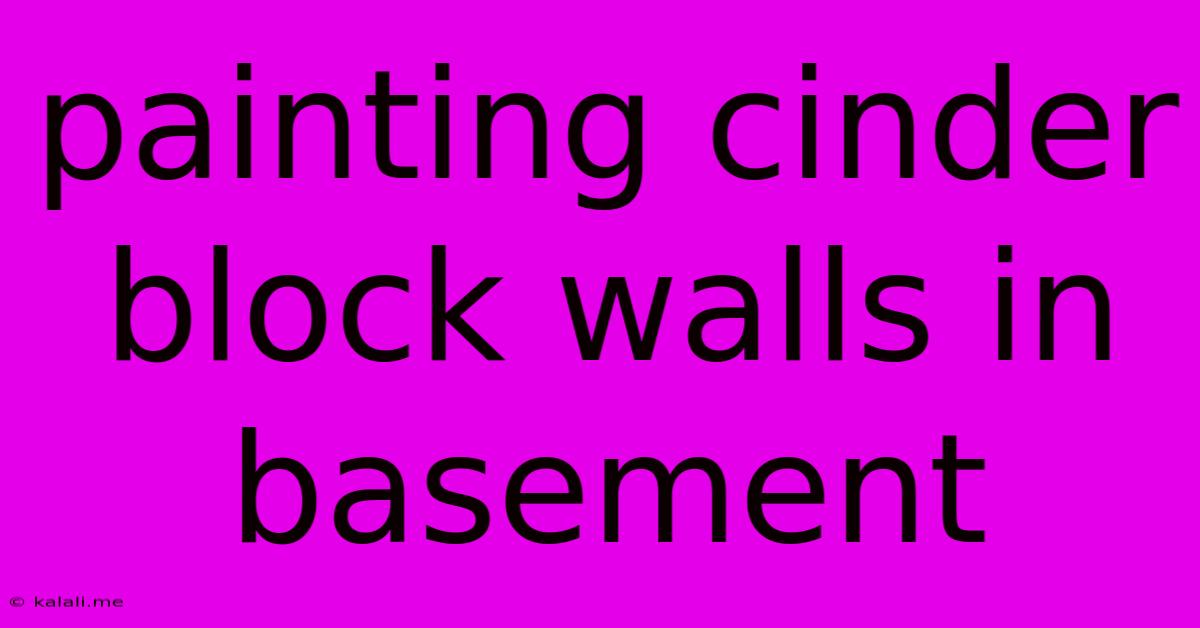Painting Cinder Block Walls In Basement
Kalali
May 23, 2025 · 3 min read

Table of Contents
Transforming Your Basement: A Guide to Painting Cinder Block Walls
Painting cinder block walls in your basement can dramatically improve its aesthetic appeal and overall value. This guide provides a comprehensive step-by-step process, covering everything from surface preparation to the final coat, ensuring a professional-looking finish that stands the test of time. This project is achievable for DIY enthusiasts, but remember safety first – always work in a well-ventilated area and wear appropriate safety gear.
Why Paint Cinder Block Walls? Beyond the obvious aesthetic upgrades, painting your basement cinder block walls offers several key advantages. It can:
- Enhance the look and feel of your basement: Transform a drab, unfinished space into a comfortable and inviting area.
- Increase home value: A finished basement significantly boosts your property's market value.
- Protect against moisture: A proper paint job acts as a barrier against dampness, preventing mold and mildew growth.
- Improve insulation: Certain paints offer additional insulation properties, reducing energy costs.
- Create a more versatile space: A painted basement is ready for various uses, from a home gym to a guest room.
Essential Tools & Materials:
- Primer: Specifically formulated for masonry surfaces. This is crucial for adhesion and preventing bleed-through from the blocks.
- Paint: Choose a paint designed for low-moisture environments and high durability. Semi-gloss or satin finishes are excellent choices for basements.
- Paint Roller & Tray: A high-quality roller with a thick nap is best for textured surfaces.
- Paintbrushes: For cutting in around edges and corners.
- Putty Knife: To fill in any cracks or holes in the walls.
- Sandpaper: For smoothing out any imperfections after filling.
- Drop Cloths: Protect your floor from spills and splatters.
- Safety Glasses & Gloves: Always prioritize safety.
- Ladder or Step Stool: To reach higher areas easily.
- Cleaning Supplies: For cleaning the walls before starting.
- Masonry Sealer (Optional): This adds extra protection against moisture, especially in damp basements.
Step-by-Step Painting Process:
1. Preparation is Key: Cleaning and Repairing the Walls
- Clean the Walls: Thoroughly clean the cinder block walls using a stiff brush, soap, and water to remove any dust, dirt, cobwebs, or mildew. Allow the walls to dry completely before proceeding.
- Repair Cracks and Holes: Use a putty knife to fill in any cracks or holes in the walls with a suitable patching compound. Let it dry completely and then sand smooth.
2. Priming for Superior Adhesion
- Apply Primer: Using a roller, apply a generous coat of masonry primer to the entire surface of the cinder block walls. Ensure even coverage, paying particular attention to corners and crevices. This will provide a better surface for the paint to adhere to and prevent bleed-through. Let it dry completely according to the manufacturer's instructions.
3. Painting the Walls: Achieving a Professional Finish
- Cut In: Use a paintbrush to carefully paint the edges and corners of the walls, creating a neat border.
- Roll the Paint: Using a paint roller and tray, apply even coats of paint to the walls, working in sections. Avoid overloading the roller to prevent drips and runs.
- Multiple Coats: For optimal coverage and color depth, apply two or even three coats of paint, allowing each coat to dry completely before applying the next.
4. Post-Painting Clean-up & Maintenance
- Clean Your Tools: Immediately clean your paint rollers, brushes, and trays with appropriate solvents.
- Ventilation: Ensure adequate ventilation in the basement after painting to allow the paint to cure properly.
Choosing the Right Paint:
Selecting the appropriate paint is crucial for a long-lasting, attractive finish. Consider the following factors:
- Moisture Resistance: Opt for paint explicitly designed for basements and damp conditions.
- Durability: Semi-gloss or satin finishes are more durable and easy to clean than matte finishes.
- Color: Choose a color that complements the overall design of your basement. Consider lighter colors to create a more spacious feel.
By following these steps, you can successfully paint your cinder block walls and transform your basement into a functional and stylish space. Remember to always refer to the manufacturer's instructions on your chosen paint and primer for specific drying times and application techniques. Enjoy your newly painted basement!
Latest Posts
Latest Posts
-
How To Get A Comb Out Of Your Hair
May 23, 2025
-
1 4 Cup Uncooked Rice To Cooked
May 23, 2025
-
What Is Your Relationship With The Patient
May 23, 2025
-
Deposit Check Made Out To Business In Personal Account
May 23, 2025
-
How To Heat Up A Chicken Pot Pie
May 23, 2025
Related Post
Thank you for visiting our website which covers about Painting Cinder Block Walls In Basement . We hope the information provided has been useful to you. Feel free to contact us if you have any questions or need further assistance. See you next time and don't miss to bookmark.